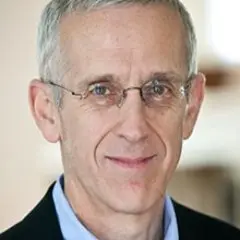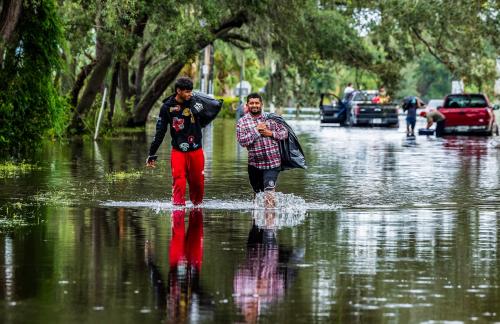
- David G. Victor
- Todd Stern
- Jeffrey Ball
- Rick Duke
- Samantha Gross
- Christina Kwauk
- Nathan Hultman
- Jenny Schuetz
- Rahul Tongia
- See More
More On
On September 23, the United Nations will host a Climate Action Summit in New York City where UN Secretary-General António Guterres will invite countries to present their strategies for helping reduce global greenhouse gas emissions. Today, experts from across Brookings share what they anticipate hearing at the summit and what policies they believe U.S. and global leaders should prioritize.
What steps are countries and industries taking to decarbonize? – David G. Victor
 The world’s diplomats have proven highly talented at holding meetings about climate and setting bold goals for action. This year we will see fresh calls for yet more ambition. But the picture on the ground isn’t getting better. Emissions last year were up 2.7%. The atmosphere and the oceans, as far as I can tell, haven’t noticed that governments have been talking for three decades about slowing global warming. Warming, in fact, is accelerating.
The world’s diplomats have proven highly talented at holding meetings about climate and setting bold goals for action. This year we will see fresh calls for yet more ambition. But the picture on the ground isn’t getting better. Emissions last year were up 2.7%. The atmosphere and the oceans, as far as I can tell, haven’t noticed that governments have been talking for three decades about slowing global warming. Warming, in fact, is accelerating.
I am looking for two things at the U.N. General Assembly meeting in New York this year.
First, I would like to hear governments talk more about concrete actions—what are they doing, with business, in key sectors to test, deploy, and scale up the technologies needed for deep decarbonization. Sure, there are a few projects here and there. Decarbonizing steel, for example, is expensive and difficult. Projects in Sweden, Austria, and a few other places are exploring options. But the totality of the effort is haphazard and not scaling at the rate needed to stop warming any time soon. Ditto for cement (another big emitter) and practically every other major emitting industry. The only sector that is showing reliable progress in cutting emissions is electric power—in the U.S. that’s because shale gas is killing coal and renewables are coming online quickly. Even there, the sector is on track for shallow decarbonization, not the 80%+ cuts needed for deep decarbonization.
Normally, the United States would be a key leader in announcing projects and efforts, but don’t expect the current U.S. government to say much that is useful on climate change.
Second, I will be spending most of my time at UNGA in meetings focused on what the oil and gas industry is doing to decarbonize. Fixing the climate problem will require strong incentives for business to change, and some of the most important technologies are most likely to come from this industry—such as low cost systems for making and handling hydrogen (a potentially important way to convey and store energy) and carbon capture and storage, which can safely remove carbon pollution from power plants and industrial sources and put it underground instead of in the atmosphere.
Gridlock on climate action has many roots. Some of them are political—the people on the front lines of climate change have voted for leaders who aren’t doing much to help fix the climate problem. Some are just chaos—the energy industry (which is the largest source of warming emissions) is in the middle of revolutions that have made it hard to figure out where to invest. In New York, I hope we will see some clearer signs from government and from civil society.
David G. Victor
Nonresident Senior Fellow and Co-Chair of the Cross-Brookings Initiative on Energy and Climate
A well functioning Paris regime is a necessary but not sufficient answer – Todd Stern
 The focus of the international climate community is now squarely on the pressing need for much more speed and scale in our efforts to build a decarbonized global economy. The risks of destabilizing, even catastrophic, climate change have become all too clear both from the rising crescendo of extreme weather events and the steady march of authoritative new studies.
The focus of the international climate community is now squarely on the pressing need for much more speed and scale in our efforts to build a decarbonized global economy. The risks of destabilizing, even catastrophic, climate change have become all too clear both from the rising crescendo of extreme weather events and the steady march of authoritative new studies.
As I write in more detail elsewhere, a well functioning Paris regime is a necessary but by no means sufficient part of the answer. More than anything, we have a shortage of true commitment around the world. We can do what it takes in terms of innovation, policy, and financing, but human will and motivation are inadequate. Leaders and policymakers need to stop asking “what can we do on climate change given the political, social, and economic challenges we confront?” and start asking “how can we maximize good political, social, and economic outcomes given what we must do to confront climate change?”
Change in attitudes and expectations is starting to happen, but we need more, the kind of mobilization that brings us to the tipping point when business-as-usual politicians and corporate leaders understand they will fail, lose office, lose their standing, and be left behind unless they meet the climate challenge head-on.
Todd Stern
Senior Fellow, Cross-Brookings Initiative on Energy and Climate
Indian businesses joining the government to take the lead on climate action – Sahil Ali
 The U.N. Climate Summit takes place against the backdrop of mixed outcomes at the COP 24 climate conference in Poland, a looming global recession, and an increasingly autarkic approach from the U.S.—the world’s largest producer and consumer of oil and natural gas. The U.N. itself has noted that the political will to fight climate change has been dwindling since the Paris Agreement, while India has re-emerged at the forefront of climate action.
The U.N. Climate Summit takes place against the backdrop of mixed outcomes at the COP 24 climate conference in Poland, a looming global recession, and an increasingly autarkic approach from the U.S.—the world’s largest producer and consumer of oil and natural gas. The U.N. itself has noted that the political will to fight climate change has been dwindling since the Paris Agreement, while India has re-emerged at the forefront of climate action.
Prime Minister Modi announced India’s intention to ban single-use plastic and restore 26 million hectares of degraded land at the recent 14th United Nations Convention to Combat Desertification in New Delhi. Since Paris, India is likely to enhance its renewable energy target to 500 gigawatts by 2030, fully electrify its railways by 2022, and has prepared a national cooling action plan.
Amidst concerns of domestic economic slowdown and growing climate-related risk factors, Indian businesses in energy intensive industries are expected to showcase their decarbonization plans aligned with the global requirement of net-zero emissions by 2050. Several companies have introduced internal and shadow carbon pricing, and more are in line to do so by 2020. With India’s estimated $2.5 trillion budget for climate action by 2030 and the drying up of international climate aid, internal revenue mechanisms such as carbon taxation and markets are likely to play the central role in India’s sustainable economic transition.
Sahil Ali
Associate Fellow, Brookings India
Climate action is shifting from the diplomats to the capitalists – Jeffrey Ball
 As rooms go, the United Nations General Assembly hall has always been more symbolic than substantive in the fight against climate change. Now more than ever, the chamber that matters most in the slog to cool the planet is the C-suite.
As rooms go, the United Nations General Assembly hall has always been more symbolic than substantive in the fight against climate change. Now more than ever, the chamber that matters most in the slog to cool the planet is the C-suite.
An accelerating shift in action from the diplomats to the capitalists may be a downer for the denizens of the annual gabfest known as the U.N. Climate Action Summit. But it’s got big upside for the planet.
Central bankers—most importantly in China, and also notably in the United Kingdom and France—are pushing corporations to disclose their climate risk in ways investors can understand and thus in ways that compel the companies to do something about it. China, the country that matters most in the climate fight, is taking steps, at least rhetorically, to green its spending in the massive infrastructure-investment program known as the Belt and Road Initiative. Money is pouring into a range of low-carbon technologies whose costs are plummeting.
How far the greening of global capital will go is what’s crucial to watch at the upcoming U.N. confab and beyond. The flow of carbon into the atmosphere is fundamentally about the flow of money on the ground. The bad news is that greenhouse-gas emissions continue to rise. The good news is that global capitalism is getting serious about decarbonizing—not just to burnish its public relations but to bolster its bottom line.
Jeffrey Ball
Nonresident Senior Fellow, Cross-Brookings Initiative on Energy and Climate
It’s time to turn from climate negotiations to national actions – Rick Duke
 With the Paris Agreement rulebook in place, it is time to redefine global climate ambition. We must shift from negotiations to national actions. From focusing only on ratcheting up future targets to holding countries accountable to current commitments. From rhetoric to policies that deploy gigawatts of clean energy and avoid gigatons of greenhouse gases.
With the Paris Agreement rulebook in place, it is time to redefine global climate ambition. We must shift from negotiations to national actions. From focusing only on ratcheting up future targets to holding countries accountable to current commitments. From rhetoric to policies that deploy gigawatts of clean energy and avoid gigatons of greenhouse gases.
Globally, plummeting costs for technologies like renewables and electric vehicles mean it has never been cheaper to act. And mitigation is a momentum game—the faster the world moves, the cheaper low-carbon solutions become (through scale economies and learning-by-doing), making it easier for governments to implement increasingly ambitious climate policies.
In the U.S., sobering science, climate-fueled disasters, federal climate policy rollbacks, and climate action advocates have put climate higher on the political agenda than ever before. The push by all major presidential contenders, other than the current incumbent, for net zero emissions by 2050 is welcome. What is needed now is clarity about how they would initiate this rapid economic transformation on their watch despite continued entrenched political resistance. We must therefore refocus debate from competition over untethered long-term targets to specific regulatory, budgetary, and legislative priorities that are politically achievable and put us on the fastest feasible emissions reduction pathway over the next decade.
Rick Duke
Nonresident Senior Fellow, Foreign Policy and the Cross-Brookings Initiative on Energy and Climate
The 2020 election can change the climate dialogue in the US – Samantha Gross
 The 2020 election cycle represents an opportunity to change the conversation about climate in the United States. For too long, the debate has pitted concern about saving the earth for future generations against supposedly insurmountable costs and harm to economic growth. This is a false dichotomy.
The 2020 election cycle represents an opportunity to change the conversation about climate in the United States. For too long, the debate has pitted concern about saving the earth for future generations against supposedly insurmountable costs and harm to economic growth. This is a false dichotomy.
Climate change is affecting people today, right now, and young people could see drastic changes in the earth’s climate during their lifetimes. As a result, we’re seeing an uptick in youth climate activism ahead of this month’s U.N. Climate Action Summit. The global average temperature has already risen by around 1 degree Celsius and the increasing frequency and strength of hurricanes, droughts, and floods shows the damage that a warming climate will bring. Support for climate action will grow when politicians make clear to voters the personal cost of inaction.
On the other side, climate action is an imperative for continued economic growth, not a detriment to growth. Investments in low-carbon energy and resilient infrastructure can bring growth and job creation right now. The U.S. is a world leader in technological innovation. Renewable electricity costs are decreasing rapidly, and innovation can bring down the costs of transition for other sectors. A just transition must include help for communities most impacted by climate change and people whose jobs are displaced. But overall, climate action now is far less expensive than the likely costs of delay.
Samantha Gross
Fellow, Cross-Brookings Initiative on Energy and Climate
Global leaders should recognize the importance of education in climate action – Christina Kwauk
 Although hundreds of thousands of students around the world are anticipated to take part in the Global Climate Strike starting Friday, September 20, it is unlikely that education will feature prominently in climate change policy discussions during the UN Climate Action Summit.
Although hundreds of thousands of students around the world are anticipated to take part in the Global Climate Strike starting Friday, September 20, it is unlikely that education will feature prominently in climate change policy discussions during the UN Climate Action Summit.
This doesn’t mean that youth will be ignored—on the contrary, U.N. Secretary-General António Guterres has been quite vocal about how students are taking the lead on climate action more than global leaders. Rather, it means that global leaders are unlikely to spend time discussing strategies to help ensure children, youth, and adults are equipped with the knowledge, skills, and attitudes to mitigate against and adapt to further environmental damage and climate breakdown.
Why will education be undercut? Two reasons: First, the global education community has not stepped up to the task of climate action. Ironically, the climate skepticism and misinformation fueling action paralysis by society could be assuaged through a more radical and ethical education rooted in social and environmental justice.
Second, how we frame the problem determines how we solve the problem. A singular focus on carbon emissions (and other greenhouse gases) means that climate solutions and climate policy have been dominated by technofixes aimed at reducing carbon and greenhouse gases. As a result, countries miss attending to more sociological solutions like education—especially girls’ education.
If the U.N. truly recognizes the importance of education in climate action, it would lead on reforming the climate change education agenda so that students can take their seats instead of to the streets—at least when it comes to climate change.
Christina Kwauk
Fellow, Center for Universal Education and Global Economy and Development
The US needs to create the conditions for a rapid transition of our economy to clean energy over the next decade – Nathan Hultman
 The top priority right now in the United States is to create the conditions for a rapid and transformational transition of our economy to clean energy over the next decade. This entails two components. First, expanding political support for climate action in states, cities, businesses, and other organizations can help drive continued generation and implementation of ambitious climate policies within those jurisdictions. These actions have kept a lid on U.S. emissions during a period of detrimental federal deregulation and lay the groundwork for enhanced action in the future, which our work has shown result in significant impacts on the overall U.S. emissions trajectory.
The top priority right now in the United States is to create the conditions for a rapid and transformational transition of our economy to clean energy over the next decade. This entails two components. First, expanding political support for climate action in states, cities, businesses, and other organizations can help drive continued generation and implementation of ambitious climate policies within those jurisdictions. These actions have kept a lid on U.S. emissions during a period of detrimental federal deregulation and lay the groundwork for enhanced action in the future, which our work has shown result in significant impacts on the overall U.S. emissions trajectory.
Second, while these actions are tremendously valuable in the short term, significant re-engagement by the federal government—both Congress and the executive branch—will be essential for catalyzing the necessary pace of transition after 2020. And given the importance of U.S. technological innovation, the size of our economy, and the need for American leadership, this re-engagement across our entire federal system is essential for reaching global climate goals. Therefore, working toward electing American leaders who support robust and well-constructed climate and energy policies is a globally existential priority for the coming 12 months.
Nathan Hultman
Nonresident Senior Fellow, Global Economy and Development
To make progress on climate change, the US must overhaul its land use policies – Jenny Schuetz
 To make progress on climate change, the U.S. must overhaul its land use policies. For 70 years, federal transportation and tax policy have subsidized building single-family homes in car dependent suburbs. Cars are one of the largest sources of greenhouse gases. Single-family homes use more energy to heat and cool than apartments in multifamily buildings. No one wants to spend more time stuck in traffic, and many are willing to pay more for housing in neighborhoods with restaurants and shops in easy walking distance. But in many metropolitan areas, amenity rich neighborhoods close to employment centers are so expensive that middle-income families are effectively pushed out. Fixing the environmental harm caused by decades of poor land use will require policy changes from local, state, and federal governments. And it means that Americans will have to drive less and live in smaller homes or pay the full social costs of their suburban lifestyles.
To make progress on climate change, the U.S. must overhaul its land use policies. For 70 years, federal transportation and tax policy have subsidized building single-family homes in car dependent suburbs. Cars are one of the largest sources of greenhouse gases. Single-family homes use more energy to heat and cool than apartments in multifamily buildings. No one wants to spend more time stuck in traffic, and many are willing to pay more for housing in neighborhoods with restaurants and shops in easy walking distance. But in many metropolitan areas, amenity rich neighborhoods close to employment centers are so expensive that middle-income families are effectively pushed out. Fixing the environmental harm caused by decades of poor land use will require policy changes from local, state, and federal governments. And it means that Americans will have to drive less and live in smaller homes or pay the full social costs of their suburban lifestyles.
Jenny Schuetz
David M. Rubenstein Fellow, Metropolitan Policy Program
An economic slowdown could hamper India’s decarbonization efforts – Rahul Tongia
 Indian Prime Minister Narendra Modi is expected to share updates from India at the U.N. Climate Action Summit, and the larger story will be on 2050 pathways for deep decarbonizing. What will likely not get enough attention are short-term issues with plans and projections, especially relevant for India which has exceptionally aggressive plans for growing renewable energy (RE) by 2022, with a target that needs more than doubling of RE in under three years, to 175 gigawatts.
Indian Prime Minister Narendra Modi is expected to share updates from India at the U.N. Climate Action Summit, and the larger story will be on 2050 pathways for deep decarbonizing. What will likely not get enough attention are short-term issues with plans and projections, especially relevant for India which has exceptionally aggressive plans for growing renewable energy (RE) by 2022, with a target that needs more than doubling of RE in under three years, to 175 gigawatts.
India is staring at a slowdown in growth (hopefully not a recession), and this has led to squeezed state finances unwilling or perhaps unable to pay for some RE projects. The automobile manufacturing industry, responsible for about 7.5% of India’s GDP, has seen a 40% drop in sales for a variety of reasons. It’s a lot easier to manage a transition (be it to RE or electric vehicles) during periods of growth.
This underscores the general plea from India and developing countries for support—financial but also technical—to make deep decarbonization happen sooner. India and many other countries are doing well with “no regrets” RE and clean energy—market-friendly growth based on falling prices of RE—but such intermittent or variable RE only goes so far. Deeper changes to the energy system, including large-scale storage, are needed for India to shift gears. The world will need to give India flexibility and breathing space to evolve aggressive yet feasible plans.
Rahul Tongia
Fellow, Brookings India and the Cross-Brookings Initiative on Energy and Climate
Authors





The Brookings Institution is committed to quality, independence, and impact.
We are supported by a diverse array of funders. In line with our values and policies, each Brookings publication represents the sole views of its author(s).








Commentary
Around the halls: Brookings experts on what to watch for at the UN Climate Action Summit
September 19, 2019